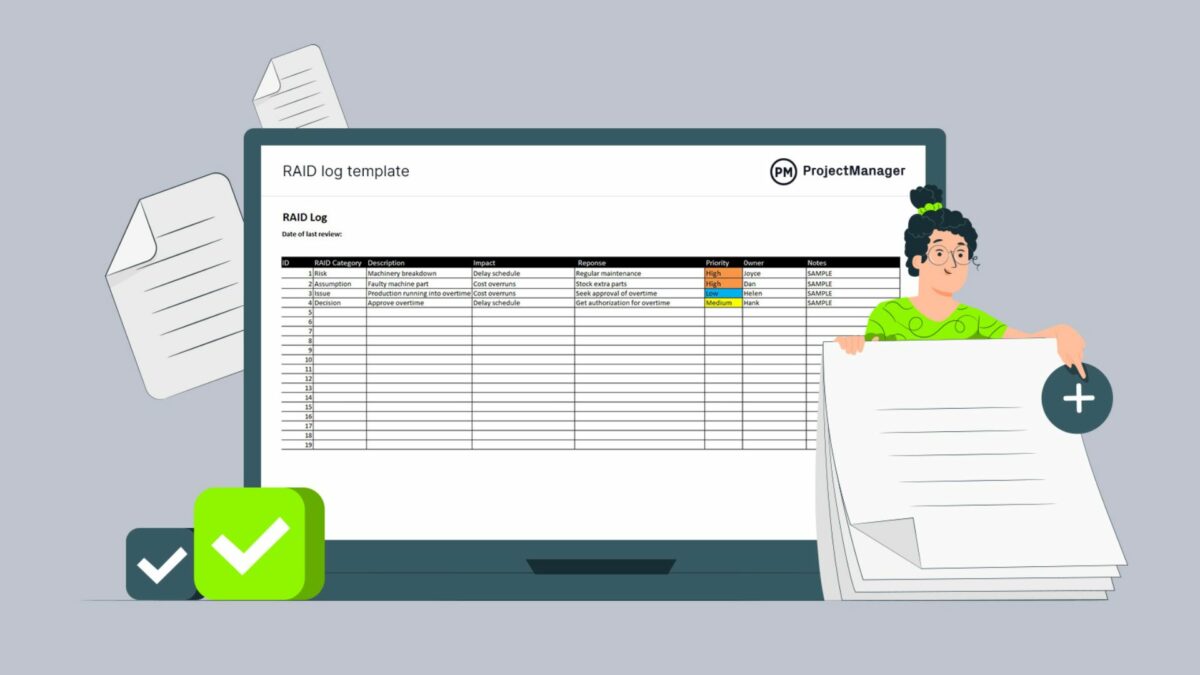Utilize RAID Log Template | Simplify Project Management
Ever found yourself tangled in a web of project management chaos? You’re not alone. I’ve been there, and I’ve got a secret weapon to share – the RAID log template. It’s a simple, yet powerful tool that can turn the tide in your favor.
The RAID log template is no magic wand, but it’s pretty close. It’s a strategic approach that helps you identify, assess, and prioritize Risks, Assumptions, Issues, and Dependencies in your project. Intrigued? You should be. Let’s dive deeper into the world of RAID log template and discover how they can revolutionize your project management game.
What Is The RAID Log Template?

Building on our former talk about RAID log’s power in navigating agile project management chaos, I’ll delve deeper into its essence, features, and application.
What Is a RAID Log?
A RAID log, acronymic for Risks, Assumptions, Issues, and Dependencies, is a project management tool that champions effective recording, assessment, and tracking of the four factors. Designed as a simple grid, RAID logs present each factor—Risk, Assumptions, Issues, and Dependencies—under separate columns, with rows often filled with detail-specific points. These points can range from numerical risk probability scores to textual descriptions of issues, offering a comprehensive overview of the project landscape at a glance. For example, under the ‘Risk’ column, you might see: ‘5% inflation rate increase’, illustrating a potential financial risk.
The Purpose of Using a RAID Log in Project Management
Given a RAID log’s compact design, it becomes an integral part in organizing critical project information. It allows managers to allocate focus and resources appropriately, with the four factors acting as guides. Tracking Risks helps preempt uncertainties that could derail project goals, while Assumptions keep the planning real and aware of preset conditions. Issues, when recorded, become alert beacons, prompting immediate corrective measures, whereas Dependencies draw attention to tasks requiring synchronization.
For instance, recognizing a high-priority Issue (like a delay in material procurement) can prompt rapid responses to mitigate project delays. The more these factors come under control, the more coordinated and efficient the project execution becomes, indicating the significant impact a RAID log has on project management tool.
Key Components of a RAID Log Template

In understanding the structure of a RAID log template, it’s essential to delve into its key elements: Risks, Assumptions, Issues, and Dependencies. These components consolidate vital project information, enabling managers to carry out effective planning, monitoring, and strategizing.
Risks: Identifying Potential Project Pitfalls
Primarily, risks represent possible pitfalls that could hinder the project’s success. In a RAID log template, I document such potential hurdles. I outline each risk alongside its impact—thus offering a clear snapshot of potential trouble spots. For instance, if exclusive reliance on a single vendor represents a risk, I document how this could disrupt the project in the event of supply issues.
Assumptions: The Basis of Project Planning
Assumptions are the underlying suppositions that form the base of project planning. They’re expectations or projections I make considering everything will function as anticipated. Assumptions in the RAID log template provide a platform for resiliency planning, showing potential operational gaps if any assumption proves incorrect. For example, one assumption could be that all team members have an appropriate skill level—if this proves wrong, it could delay project timelines.
Issues: Monitoring Current Challenges
Issues in a RAID log represent any ongoing challenges plaguing the project. They make up the real-time problems demanding immediate attention. I capture these issues, classifying them according to their level of urgency and effect. Suppose technical glitches are halting progress—this issue gets added to the RAID log template highlighting the urgency to resolve it.
Dependencies: Managing Inter-Project Relationships
Lastly, dependencies depict the tasks or operations within the project reliant on each other. In a RAID log template, I notate these interdependencies, detailing their nature and potential impact. This process visualizes links between tasks, enabling a smoother orchestration of project tasks. A dependency could be that the development team can’t start their work until the design team finishes—this can be recorded to ensure proper task scheduling.
Implementing the RAID Log in Your Projects

After understanding the individual components of a RAID log template and their significance, it’s time to know how to implement this powerful tool in our projects. With strategic timing and regular updates, a RAID Log becomes an accurate reflection of a project’s health and an invaluable tool for proactive project management.
When to Start Your RAID Log?
The inception points of a RAID log vary among projects. Generally, starting your RAID Log during the early stages of the project allows for comprehensive documentation and monitoring of Risks, Assumptions, Issues, and Dependencies. An initial RAID Log commonly forms part of the project initiation documentation, which sets direction for subsequent steps. Though it may seem like the project is inundated with risks and issues in the initial stages, documenting them early eases their management and reduction process.
Keeping Your RAID Log Updated
The static nature of a RAID log is clearly a myth. The biggest advantage of maintaining a RAID log is its morphing ability that begs for constant updates.
In the course of a project’s progression, things may change rapidly – some risks may elevate, some issues may resolve, assumptions may prove incorrect, and dependencies can evolve. With such dynamic changes, regular review and updates to the RAID Log provide an anchor to the project management process.
A RAID log isn’t just a one-time document; instead, it’s the bible for project managers that requires constant revisiting and updating. At regular intervals, such as weekly or biweekly project review meetings, evaluating the RAID log and updating its components ensures that the project stays on course or if required, necessary adjustments can be brought into action promptly.
Best Practices for Maintaining an Effective RAID Log

Maintaining an effective RAID Log can be a breeze if you adhere to certain best practices, thus aiding in successful project management.
Consistency Is Key
When it comes to working with a RAID log, consistency in updates is critical. This function implies reviewing the log regularly, ensuring that all risks, assumptions, issues, and dependencies are captured accurately. Regular checks and updates help in tracking the evolution of individual items, thereby allowing project managers to see patterns for instance, which risks are occurring frequently, or which assumptions are consistently off the mark.
Integration with Other Project Management Tools
The RAID log isn’t a standalone tool, but rather, it complements other project management tools. For instance, the Gantt chart, a popular project management tool, focuses on timelines, tasks, and who’s accountable – by integrating it with a RAID log, project managers can identify potential obstacles to the completion of tasks. Similarly, integrating a RAID log with a Kanban board, a tool designed to manage workflow, brings visibility to potential bottlenecks, diversions, and risks in the workflow. The integration of RAID logs with other project management tools can produce a more holistic, dynamic project management system. Remember, it’s about fostering an environment where the RAID log communicates seamlessly with other tools, enhancing overall project efficiency.
Examples of RAID Logs in Action

Building on the essentials of RAID logs, let’s delve deeper and present two key segments. First, a case study demonstrating successful deployment in large projects, followed by some notable lessons drawn from common mistakes.
Case Study: Successful Deployment in Large Projects
Consider a multinational corporation launching a global digital transformation project. Impacting multiple departments across diverse geographic locations, it’s not hard to imagine the magnitude of risks, assumptions, issues, and dependencies involved. Let’s visualize the application of a RAID log in such a scenario.
- Risk: A significant obstacle might be the lack of technological infrastructure in some regions, posing a risk to the uniformity of the project rollout. In this instance, the RAID log, listing this as a risk, facilitates its early identification and prioritizing, thereby enabling development of mitigation strategies, such as advance procurement or local collaborations.
- Assumption: The assumption that all regional teams possess adequate training to implement the new technology could potentially backfire if left unchecked. The RAID log acts as a reminder to validate this assumption, provoking queries, like “Have all teams undergone necessary training?”
- Issue: An emerging issue could be resistance from employees in adopting the new technology. Documented in the RAID log, this issue doesn’t remain unnoticed and stirs early discussion and resolution.
- Dependency: The project’s successful deployment may depend on vendor support for software installation. Stating this point out in the RAID log aids in assigning responsibility to track vendor commitment.
Utilizing the RAID log in this manner ensured effective project tracking, risk mitigation, assumption validation, issue resolution, and dependency management. Thus, the project registered a seamless rollout, testament to this strategic tool’s value in large-scale project management.
Lessons Learned: Common Mistakes to Avoid
Though a RAID log is a potent tool in project management, it’s susceptible to ineffective usage. Let’s unravel some common mistakes that can dilute this tool’s potential.
- Neglecting Updates: RAID logs require constant updating for retaining relevance. Ignoring this fact will only render your RAID log obsolete and ineffective.
- Undefined Ownership: Every risk, assumption, issue, and dependency must have an assigned owner who’ll take accountability. Accountability eases follow-ups and enables faster resolution.
- Poor Communication: A RAID log isn’t beneficial unless communicated effectively. Miscommunication or non-communication of RAID log updates can lead to impeded project progress.
- Lack of Integration: The RAID log isn’t an isolated tool. It needs integration with other project management tools like Gantt charts or Kanban boards for optimal results.
Avoiding these blunders can harness the full potential of RAID logs, transforming them from just another document to a powerful project management engine.
Conclusion
Overcoming project management chaos isn’t an uphill battle if you’ve got the RAID log template as your strategic tool. It’s your go-to for identifying and prioritizing Risks, Assumptions, Issues, and Dependencies. As we’ve seen, the RAID log isn’t just a fancy acronym, it’s a practical tool that can make a world of difference in large projects. It’s an ally in risk mitigation, assumption validation, issue resolution, and dependency management. But remember, the RAID log’s power lies in its proper use. Don’t fall into the trap of neglecting updates or poor communication. Make sure there’s clear ownership and integrate it with your other project management tools. With these best practices, you can harness the full potential of the RAID log template and elevate your project management game.
Frequently Asked Questions
Q1. What is a RAID log template in project management?
A RAID log template in project management is a strategic tool that helps identify, assess, and prioritize Risks, Assumptions, Issues, and Dependencies within a project environment. It serves as a mechanism for tracking each aspect and ensuring their effective management.
Q2. How do RAID logs aid in project management?
RAID logs aid in project management by promoting risk mitigation, assumption validation, issue resolution, and dependency management. They ensure comprehensive tracking of project activities, help in managing unpredictability and increasing the success rate of projects.
Q3. What are examples of RAID Logs in action?
The article provides a case study showcasing the success of RAID logs in large projects. This exemplary use of the RAID logs highlights their effectiveness in tracking and managing Risks, Assumptions, Issues, and Dependencies and achieving successful project completion.
Q4. What are common mistakes to avoid when using RAID logs?
Common mistakes to avoid when using RAID logs are neglecting updates, undefined ownership, poor communication, and the lack of integration with other project management tools. These errors can compromise the effectiveness of RAID logs in project tracking and management.
Q5. Why is it important to adequately utilize RAID logs?
Adequate utilization of RAID logs enhances project management practices. It minimizes the chaos caused by project risks, assumptions issues, and dependencies and ensure smoother, more predictable project execution.

Leave a Reply